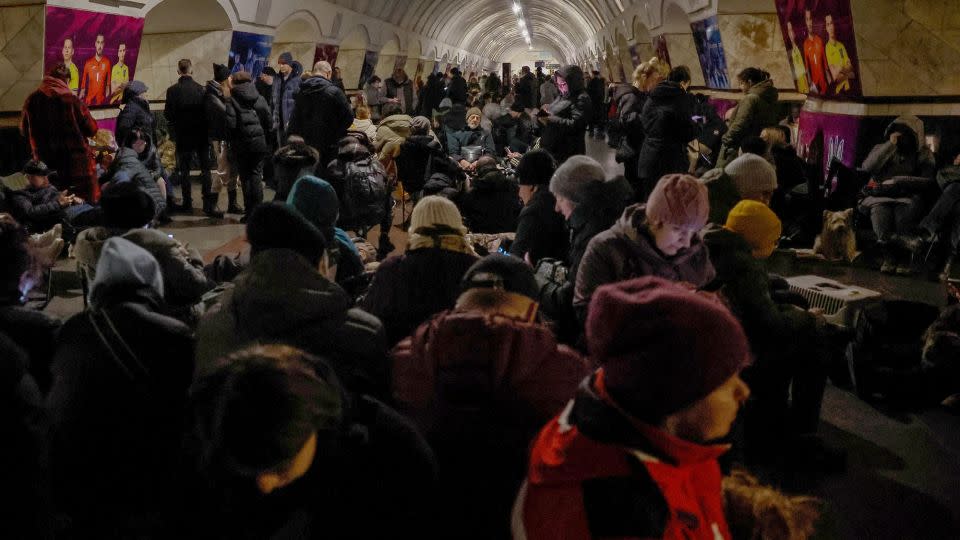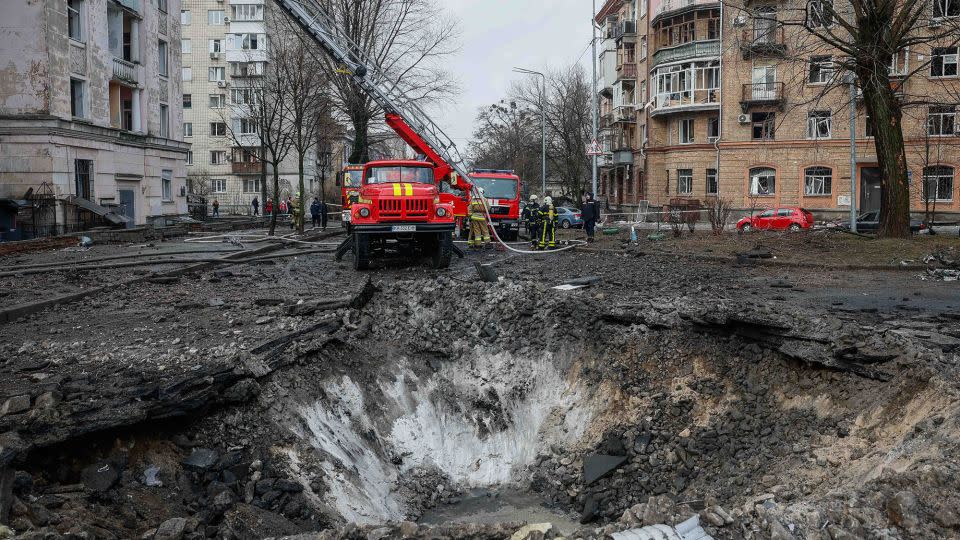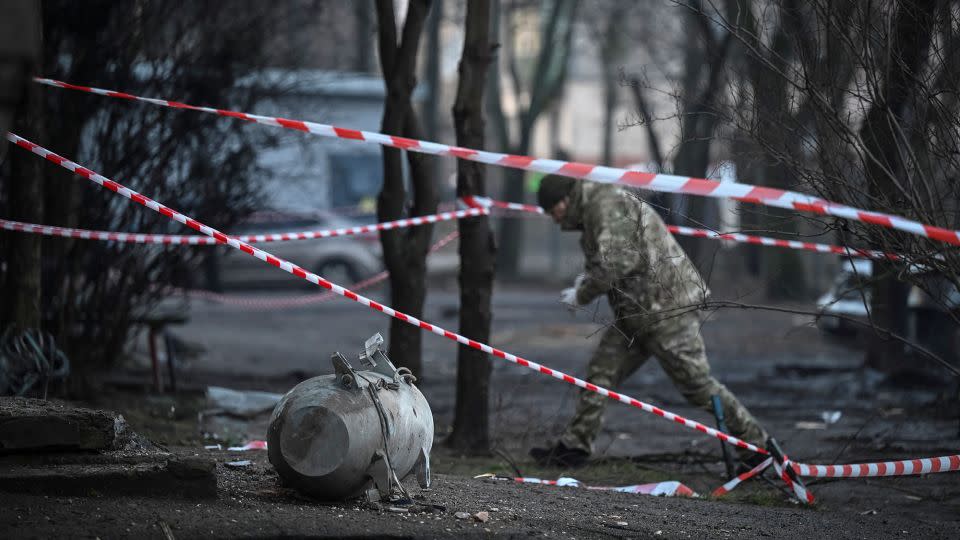Thousands shelter from Kyiv missile barrage, hours after Biden’s national security adviser visits
Ukraine’s capital came under heavy missile attack in the early hours of Thursday for the first time in six weeks just hours after a visit to the city by US national security adviser Jake Sullivan.
More than 25,000 people took shelter in the city’s metro stations while the attack was ongoing, with videos and images shared on social media showing crowds crammed together underground in images reminiscent of the early days of the war.
Officials said Russia fired two ballistic missiles and 29 cruise missiles at the Kyiv region - all of which, they said, had been shot down. Tests will confirm exactly what missile types were fired, but a statement from the air force suggests it is possible the ballistic missiles were of North Korean origin.
Authorities say about a dozen people were injured from falling debris; there were no reports of any fatalities.

Valentyna Ivanivna, an 80-year old living in Kyiv’s central Podil district, told CNN she was woken at 5 a.m. by a loud blast that shattered her windows.
“I don’t know whether it was a missile or what it was, but now I have holes instead of windows. I’m alright, but my kitchen and a living room are now windowless. I was sleeping in the bedroom, which is behind another wall, which saved me from the shrapnel,” she said.
Anastasia Shulha showed CNN inside her flower shop, which had also had its main window blown out and front door damaged.
“Actually, this is the second time my shop has suffered an attack. Last time it was late spring last year,” she said.
Pointing to the damaged shop door, she added, “Everything is wide open, and anyone could get in. it. I am going to need to stay here until the window and the door are replaced.”
Ruslan Kravchenko, head of the Kyiv region military administration, said there were no hits to critical infrastructure facilities or residential buildings - though pictures suggest at least one close call.
Videos and images show a large crater just meters away from high-rise residential buildings. One image shows nearby cars covered in soil thrown up by the impact.

More than 25,000 people, including 3,000 children, sheltered in the city’s metro stations until shortly after 6 a.m., when the air raid warning was lifted, the Kyiv city office said.
Ukraine’s President Volodymr Zelensky said the latest attack was a reminder of why he is pleading for more military support from allies.
“Russian terrorists do not have missiles that can bypass the defense of [US-made] PATRIOTs and other world-leading systems. Now this protection is needed here in Ukraine [..] This is quite possible if our partners have enough political will,” he wrote on social media.
An air force statement suggested the ballistic missiles were either KN-23 type, an Iskander-M class missile made in North Korea, or the Kh-47M2 type, which is Russian made and more commonly known as the Kinzhal. Last month, a Ukrainian official said missiles from North Korea had been used by Russia on dozens of occasions to strike Ukraine.
Defense Intelligence targeted: source
A Ukrainian defense source told CNN that based on the trajectory of the missiles, it was clear that all but one had been targeting facilities of Ukraine’s Defense Intelligence facilities.
The Defense Intelligence is run by Kyrylo Budanov and has carried out a series of high-profile attacks on Russian targets, including a number of hits on naval vessels belonging to Russia’s Black Sea fleet.
The directorate is also responsible for coordinating several units of Russian volunteers who are fighting for Ukraine. Most recently, these groups have been involved in cross border raids, as well as drone and artillery attacks, on Russia’s Belgorod and Kursk regions, which neighbor Ukraine to the north.
Some of those fighters gave a press conference in Kyiv Thursday - which took place after the missile barrage but had been announced earlier in the week – at which they said they had retaliated for the strikes on the Ukrainian capital by launching a drone strike on Belgorod.
One of the volunteer fighters, Oleksey Baranovskiy, of the Freedom for Russia Legion, said their recent actions had succeeded in thwarting Russia’s offensive plans designed to coincide with Russia’s presidential election.
Another, Denis Nikitin of the Russian Volunteer Corps, said, “We were able to open a second front. Move the war effort on to enemy territory. By extending the front line, we managed to weaken the pressure of the Kremlin’s military machine along other parts of the front.”
North Korea supporting Russia: US
U.S. and South Korean officials have accused North Korea of supplying Russia with missiles and other military equipment in recent months.
National Security Council spokesperson John Kirby said at a White House briefing in early January that Russia had fired North Korean-made missiles at Ukraine on December 30 and January 2.
Kirby and analysts who spoke with CNN said the introduction of the North Korean weapons into the war in Ukraine will reverberate 7,500 kilometers (4,600 miles) east to the Korean Peninsula. “This is a significant and concerning escalation in the DPRK’s support for Russia,” Kirby said.
On February 26, South Korean Defense Minister Shin Won-sik said North Korean munitions factories producing weapons and shells for Russia are “operating at full capacity.” In return, Russia is providing North Korea with food and other necessities, he said.

On Wednesday, Sullivan told reporters in Kyiv he remained confident the US House of Representatives would eventually approve additional military aid for Ukraine despite it having been blocked – in various iterations - in Congress for months.
Last month, the US Senate approved a supplemental bill which would have unlocked $60 billion of military aid, but House Speaker Mike Johnson refused to bring it to the floor for a vote. Current discussions on Capitol Hill are reportedly focusing on trying to get at least some of the aid approved in the form of a loan, which might secure support from House Republicans.
“We are confident we will get a strong bipartisan vote in the House for an assistance package for Ukraine and we will get that money out the door [..] It’s already taken too long … I’m not going to make predictions about exactly when this will get done,” Sullivan said Wednesday, on what was the first visit to Ukraine by a top White House official in six months.
First NATO visit since Russian invasion
The strikes in Kyiv came on the same day as a NATO military delegation made its first visit to the Ukrainian capital since the start of the Russian invasion in 2022.
The delegation – led by Adm. Rob Bauer, the chairman of the alliance’s military committee – attended the annual Kyiv Security Forum and met with President Zelensky and Ukraine’s army chief, Oleksandr Syrskyi.
Bauer in a speech called the visit “a testament to the fact that NATO and Ukraine are closer than they have ever been.”
“This war is about President Putin fearing something much more powerful than any physical weapon on earth: democracy,” he said, adding that “if people in Ukraine can have democratic rights, real democratic rights, then people in Russia will soon crave them too.”
Bauer also said Ukraine has “fundamentally changed many aspects of modern warfare” by using “combinations of Soviet style equipment with modern Western materiel.”
The official warned Ukraine against “becoming overly pessimistic in 2024” and stressed that “pessimists don’t win wars.”
“There is nothing you cannot do. The only thing you need is our help. NATO allies and many other nations around the world are providing unprecedented support to Ukraine and it has made a real difference,” he said.
Zelensky described Bauer’s visit as “a strong signal of support” for Ukrainian society.
Additional reporting by Mariya Knight and Yulia Kesaieva
For more CNN news and newsletters create an account at CNN.com


